TASSIE THE ULTIMATE HOLIDAY FISHING OPTION
According to Shane Mensforth, Tasmania offers an amazing array of angling choices that are within easy reach of all South Aussies.
As I wrote this piece in early May, Jetstar was offering flights from Adelaide to Hobart for $76. Without even thinking twice, I booked two seats for travel in late August. It’s just a two-hour direct flight, which means I can leave home in the morning and be fishing by mid afternoon the same day – if so desired.
I’ve been to Tasmania so many times in recent years and caught so many spectacular fish, I start to get withdrawal symptoms if I’m away for too long! And while this $76 one-way airfare is naturally well below the norm, even standard flights are pretty affordable. Offpeak holiday accommodation is reasonably priced too, and rental cars are freely available from either Hobart or Launceston. The other travel alternative, of course, is to hop aboard the Spirit of Tasmania ferry (which departs from Geelong and arrives in Devenport), but you’ll pay a lot more, particularly if you take your own car across.
Despite being an ‘average’ fly caster, I adore this style of fishing, and there’s no doubt it has been the major driving force behind my frequent trips to Tassie. I’ve been lucky to strike up great friendships with a couple of Tassie’s top trout guides, as well as a guy I used to teach who moved there from Adelaide and has helped me no end over the years. Some of the trout I’ve been fortunate enough to catch during my Tasmanian visits have been incredible, thanks mainly to the guides and their first class advice. Most of these fish have been hooked on fly, but I’ve also caught plenty on spin tackle in various waterways.
For those who may not be that interested in catching trout, Tasmania offers so much more, particularly for South Aussies. It has one of the best southern bluefin fisheries in the world, and it’s probably the most likely location in the country for adventurous anglers to lock horns with a broadbill swordfish. The bream are way bigger on average than we see here and, of course, the King George whiting are truly enormous along much of the North -East Coast. I’ve been fortunate enough to sample a good cross section of all these fisheries, and have rarely failed to be impressed.
Let’s take a look at what a visiting South Aussie angler can expect during a short or extended stay on the Apple Isle. We’ll go species by species to provide as much relevant info’ as I can pack into one article.
BREAM
The best black bream I’ve caught in Tasmania to date was a chunky fish of just over 40cm, taken on a soft plastic near a derelict wharf on the lower Derwent River in Hobart. This was the only one I managed to land from half a dozen hook-ups in extremely rough territory, and there’s no doubt there were some of better than 50cm that blew me away on 3kg line. The Derwent carries a significant population of big bream (the same species we see here in SA), but there are many bream strongholds in other smaller coastal rivers and estuaries.
The warmer months – from October through until March – provide the best fishing, particularly in the shallower areas, but Tassie is essentially a year-round proposition if big bream are your thing. While I have only fished a handful of waters, mainly around Hobart and on the North and East
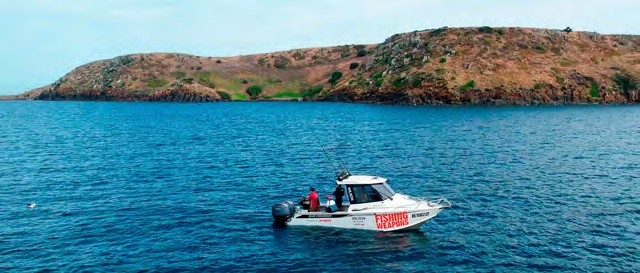
Fishing for whiting with Hook, Line & Sinker
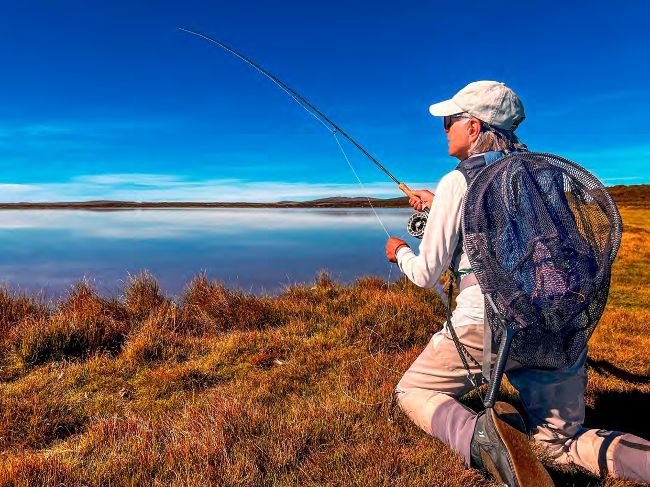
Renowned guide, Karen Brooks, stalks a big brown in a highland lake

Adam Chapman with a superb night-time brown

The final stages of an epic swordfish fight
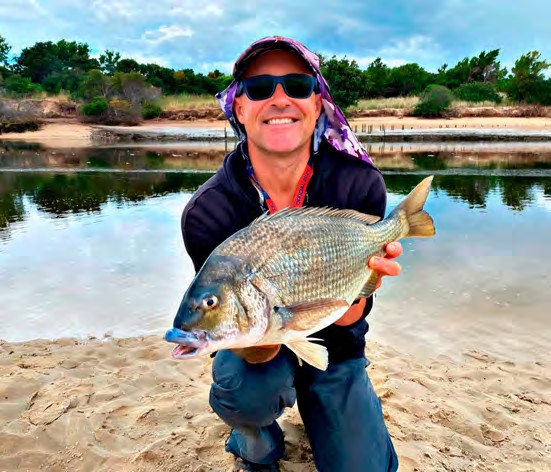
Damon Sherriff with some Bridport bream
Coasts, the average size of the bream has been exceptional. My good friend, Damon Sherriff, who lives in the delightful township of Bridport, is a bit of a local expert on the big bream in his local area and regularly pulls 45cm-plus fish within ten minutes of home. Damon is also a whizz on the local mega-whiting, but I’ll leave that for later on.
Most of the tackle and techniques that work on big South Aussie bream will bring results in Tasmanian waterways. Small soft plastics, vibes and hard-bodies are the go-to lures, and light threadline gear is undoubtedly the best option. If you’ve chased bream on Kangaroo Island, you’ll feel right at home in many of the Tassie coastal streams, which are strikingly similar.
KING GEORGE WHITING
Coming from what’s essentially the home of whiting fishing in Australia, I’m often asked what it is about chasing Tasmanian KG’s that keeps drawing me back. The answer, of course, is size. Nowhere else in the country can you catch 50cm-plus whiting with such regularity – and I simply adore slugging it out with these giants in shallow water on light gear. On my last visit to Tassie’s North-East Coast we seriously targeted big whiting for two days, managing our bag limit (five per person) on both trips with most fish over 50cm. The best was a true ‘horse’ of exactly 60cm, caught by Damon Sherriff, which probably weighed in excess of 1.6 kilos.
My two most memorable Tasmanian whiting expeditions have come from the Tamar River estuary near Low Head (50km from Launceston), and from Waterhouse Island, not far from Bridport. Both involved small boat fishing in shallow water, where it was possible to use just 4kg line and actually see the fish we were targeting. On light tackle, KG’s of this size are a heap of fun to catch. They regularly pull 15-20m of line off the reel in a series of vertical runs, often forcing you to pass the rod tip around the motor
These Tassie whiting are invariably built like proverbial brick outhouses, with thick shoulders and more stamina than just about any I’ve caught here in SA. Unhooking a big one is like trying to wrestle a sausage dog! It’s imperative to use robust terminal tackle on these fish, which means upgrading to a minimum of 8kg trace and making sure your knots are right up to scratch. Circle hooks in size 2/0 are standard equipment, and the most popular bait is freshly-caught squid.
Fortunately, there are usually plenty of squid on or close to the whiting grounds, and berleying isn’t as widely practised as it is here. There are often plenty of undesirables competing with the KG’s for your baits (the same ‘rubbish’ fish we find in SA), so berley isn’t popular among the local whiting specialists.

The inshore whiting grounds near Waterhouse Island and nearly always demanding a landing net to bring aboard safely.

Matt Sherriff with a monster KG from the Tamar estuary
Most Tassie whiting chasers fish quite a bit differently than we do. Whereas we tend to employ two-hook rigs and hold the rod, they seem to prefer a single hook set-up and use their rod holders between bites. They fish with a medium drag, allowing the circle hooks to do their thing, generally only picking up the rod once a fish has hooked itself. It seems to work pretty well, resulting in few missed bites and a high retention rate.
The seemingly modest daily bag limit of five whiting per angler per day makes good sense if you think about it, reflecting Tasmanian Fisheries’ conservative approach to looking after their unique King George population. Interestingly, these mega-whiting haven’t always been there; in fact, only in the last decade or so have their numbers grown to the level we see today. Five of these fish would be equivalent in flesh weight to ten of ours here in SA, so there’s really no need to take more.

Merrilyn’s PB 54cm Tassie whiting
What a genuine 60cm King George looks like
I was interested to see how these Tassie KG’s stack up on the plate compared to ours, as most South Aussies would agree that a 35-38cm fish is probably the optimum size for the table. As I invariably do with truly big whiting from home waters, I filleted my first lot of Tasmanian fish, skinned them and cooked them in the lightest of tempura batters; so light, in fact, that it ended up almost paper thin after a couple of minutes in super-hot peanut oil. And the result? Local fishing guide and good mate, Ken Orr, reckoned it was the best fish he had ever tasted, and I found it difficult to disagree. We struggled to eat more than one fillet each, particularly when served with wedges and a tossed salad.
It’s possible to catch big King George whiting for much of the year around Tassie’s North-East coast, but they do disappear for a few weeks from late March through until mid May, when they move into deeper water to spawn. Prime time is probably December through until early March.
There are a few charter operators who will take visiting anglers out to chase the whiting of a lifetime, and they won’t cost you an arm and a leg. These are becoming increasingly popular with Victorians, who are gradually waking up to the whiting treasure trove just a few hours from home. One operation that comes highly recommended is Adam Cousens’ North Tasmania Fishing Charters, based in Beauty Point, about 45km from Launceston. If you follow him on Facebook, you’ll see Adam’s track record on truly big whiting is exceptional, and you’ll find his rates are pretty good, too. I’m yet to fish with Adam, but plan to look him up when I’m there in August.
Hopefully, the strict bag limits and little commercial pressure will serve to protect what is undeniably the premier King George whiting fishery in Australia.
TROUT
Many agree that Tasmania is blessed with one of the best trout fisheries in the world. Brown trout were introduced from England in 1864, with eggs packed in moss and kept cool for the lengthy sea voyage. Hatchlings were then introduced to the Plenty River – and the rest, so the saying goes, is history. Rainbows were brought in from North America in 1898, and have also flourished in Tassie’s climate, which is considered ideal for most of the salmonid species.
I’ve been chasing trout all over Tassie for more than 30 years, fishing all types of waterways with both fly and spin tackle. As already mentioned, I’ve been very fortunate to be hosted by some of the best trout guides on the Apple Isle, resulting in some truly spectacular catches on some of the most beautiful waterways imaginable. I have already owned up to being an ‘average’ fly caster, relying heavily on the experts to put me in the right place at the right time, and I’m certain the success I have enjoyed would have been far less without one of them by my side. It’s possible, of course, to chase trout in Tassie unguided, but for the less experienced at least, I can guarantee that hiring an accredited guide will increase your chances of success markedly. If you’re looking for a reputable trout guide, I’d suggest logging onto the TGALT (Trout Guides And Lodges of Tasmania) website for a full list of contacts.

Many Tasmanian public waters are subject to closed seasons for most of the cooler months to enable wild trout to spawn. As browns and rainbows spawn at slightly different times, the seasonal closures are adjusted to suit; this year designated rainbow trout waters closed on June 1 and reopen on September 28, and brown trout waters closed on April 27 and reopen on August 3. There are quite a few waters that remain open year-round, including well known lakes like King William and Pedder.
An alternative to public waters fishing – and one I’ve been fortunate enough to enjoy on many occasions – is chasing trout in private fisheries. There are quite a few properties around Tasmania that are set up and maintained specifically to cater for visiting anglers who might wish to chase trout in confined waters. Many of these offer on-site accommodation and the option of guided fishing if so desired, and I can tell you from experience that they are well worth looking into.
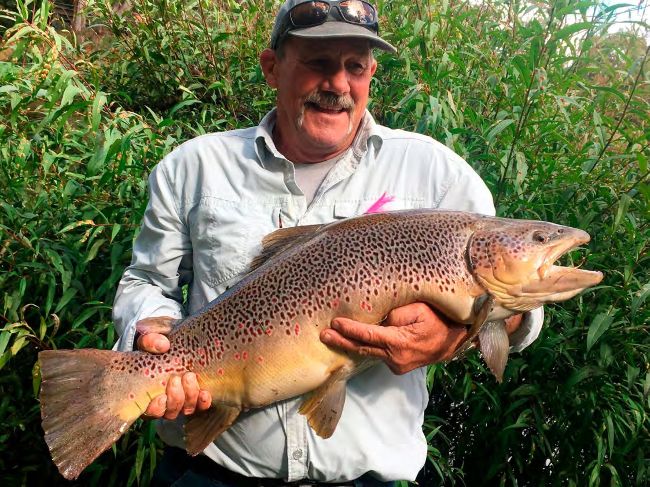
Private waters produce big trout every season
Most of the truly big browns and rainbows I’ve caught on fly in Tassie have come from private waters, including two rainbows weighed at over 20 pounds and several brownies at better than ten. Although many fly fishing purists don’t rate trout caught in private waters, I have no qualms about making a couple of private water stop-overs on each visit. For someone like me, who does very little trout fishing outside of Tasmania, the convenience afforded by private waters (and the opportunity to lock horns with double figure browns and rainbows) is invariably the way to go between sorties to the public lakes and streams.
Three of these that have really stood out are 28 Gates, Twin Lakes and Currawong Lakes.
You don’t require a licence to fish them, they are not subject to seasonal closures, and each offers extremely comfortable accommodation that puts you within minutes of the water. Both Twin Lakes and 28 Gates are about an hour’s drive from Hobart airport, while Currawong is located near Campbell Town and a bit over two hours from the city. As well as plenty of big browns and rainbows, 28 Gates and Twin Lakes are stocked with tiger trout, which are a brown trout/brook trout hybrid. They pull like the proverbial freight train and are among the most beautiful of all the salmonids you’ll find in Tasmanian waters.
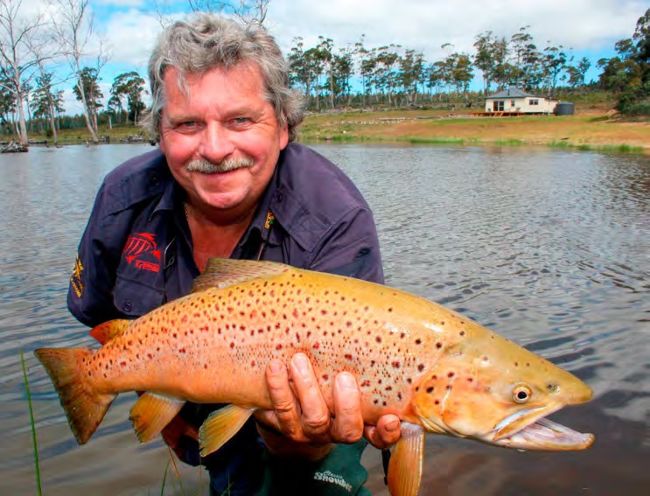
Highly respected trout guide, Ken Orr, with a lovely brownie from Twin Lakes

A broadbill, estimated at around 250kg, about to be released

Eaglehawk Neck is ‘barrel’ bluefin central (Jonah Yick image)
There are few public waters in Tasmania that don’t carry trout, and Inland Fisheries does a superb job of maintaining populations and looking after the health of lakes, streams and rivers. It’s difficult to argue about paying for a public waters fishing licence that enables access to some of the very best freshwater fishing in the country.
BLUE WATER FISHING
Over the years I’ve only spent a couple of days chasing gamefish in Tassie, but I have several close mates who devote a lot of time in pursuit of bluefin tuna, mako sharks and broadbill swordfish. All three are available here in SA, but none are as readily accessible to trailer boats here as they are from renowned Tasmanian locations like Eaglehawk Neck, Bicheno or St Helens. A few striped marlin and yellowfin tuna turn up from time to time as well, but only when unusually warm water pushes its way down the East Coast.
Eaglehawk Neck is undoubtedly the hub of Tasmanian blue water gamefishing. Situated on the Tasman Peninsula about an hour’s drive east of Hobart, this delightful little port is home base to a fleet of moored gamefishing boats, as well as several charter operations that offer anything from light tackle tuna and bottom bouncing (often specialising in Tassie trumpeters) to full-blown heavy tackle action on ‘barrel’ bluefin, big makos and broadbill.
Swords to over 200kg have been brought into Eaglehawk Neck, often hooked less than half an hour’s run from the harbor. These majestic fish certainly aren’t for everyone, but catch numbers would suggest there is no better location in the country to have a go if you are up for the ultimate blue water challenge.
OTHER SPECIES
As far as other light to medium tackle fish are concerned, Tasmania offers an array very similar to those we find here in SA. Silver trevally, southern bluespot flathead, mullet, salmon, garfish and calamari are easy to find in most estuaries and inshore reef areas, as well as some yellowtail kings and snapper along the North-East coast. You don’t need a boat to access productive fishing, but there are quite a few charter businesses dotted around the coast to take you out at a reasonable cost.
Merrilyn and I did a two-week motor home tour of Tasmania a few years back and rarely missed out on catching a feed of quality table fish in the estuaries we visited. The flatties were particularly abundant, and there seemed to be trevally of various size wherever we tried. We also managed some massive calamari from the shore, so were never short of quality seafood, right
SUMMING UP
By this stage I guess you’ve picked up on the fact that I love Tasmania – probably more than any other interstate location. Ease of access, relative affordability, friendly, helpful people and, above all, fabulous all-round fishing combine to make a Tassie holiday something to look forward to. It’s a place all South Aussies should experience whenever the opportunity presents. along the East Coast.

The author’s PB brown trout from a Tassie private water